Serapis Bey/ru: Difference between revisions
Avepaulina (talk | contribs) (Created page with "Серапис Бей тоже продолжал перевоплощаться на берегах Нила, откладывая свое вознесение прибли...") |
Avepaulina (talk | contribs) (Created page with "=== Архитектор Великой Пирамиды ===") |
||
| Line 25: | Line 25: | ||
Серапис Бей тоже продолжал перевоплощаться на берегах Нила, откладывая свое вознесение приблизительно до 400 года до н. э. В течение этих жизней он руководил возведением величайших архитектурных сооружений, когда-либо построенных на Земле. | Серапис Бей тоже продолжал перевоплощаться на берегах Нила, откладывая свое вознесение приблизительно до 400 года до н. э. В течение этих жизней он руководил возведением величайших архитектурных сооружений, когда-либо построенных на Земле. | ||
=== | === Архитектор Великой Пирамиды === | ||
[[File:Kheops-Pyramid.jpg|thumb|alt=caption|The Great Pyramid]] | [[File:Kheops-Pyramid.jpg|thumb|alt=caption|The Great Pyramid]] | ||
Revision as of 05:29, 8 June 2022

Серапис Бей является Чоханом Четвертого луча, иерархом Храма Вознесения в Луксоре и тринадцатым членом Совета Адептов Храма Вознесения. Он также известен под именем Сераписа Солейла (Сераписа Солнца).
Четвертый луч — это луч пламени вознесения, белого света Матери в чакре основания позвоночника. Из этого белого света рождаются архитектура, принципы математики, формулы построения телесного храма и пирамиды Я. В присутствии Сераписа человек совершенно по иному осознает то, что мы называем Христом, подлинной личностью любого из нас.
Воплощения
Серапис, известный как сторонник строгой дисциплины, пришел с Венеры вместе с Ветхим Днями, дабы вновь зажечь священный огонь в сердцах заблудшего человечества. Его неиссякаемый энтузиазм в деле возвышения сынов человеческих до положения царей и жрецов Божьих превратился в пламя железной воли, решимости и дисциплины.
Высший жрец в Храме Вознесения
Он был жрецом в Храме Вознесения на Атлантиде. Будучи хранителем пламени вознесения, он благополучно перенес это пламя в Луксор в Египте прямо перед затоплением Атлантиды. Серапис делится с нами своими воспоминаниями об этом событии:
Я хорошо помню, когда появились первые грозные признаки затопления Атлантиды. Ибо, как вам известно, этот континент погружался в воду в несколько этапов. По милости Бога, предупреждение о надвигающейся опасности позволило многим спастись. Вняв предостережению, мы отправились в Луксор...
Вам может быть интересно, почему необходимо, чтобы простые смертные переносили духовное пламя. Дети света часто считают, что подобные события должны происходить непременно волшебным и чудесным образом. Возможно, элементы сказки проникли в религию, и люди забыли, что все, сотворенное Богом и человеком, было плодом их совместной работы и усилий как Вверху, так и внизу.
Что ж, я скажу вам, почему это так: дело в том, что единственное место, где пламя действительно может пребывать, если не считать алтаря, посвященного специально этой цели, — это живое сердце живого адепта.[1]
Там, в Египте, Серапис и сопровождавшие его братья воздвигли Храм Вознесения, и с той поры хранили здесь пламя, сменяя друг друга в этом служении по мере того, как они перевоплощались специально для этой цели.
Серапис Бей тоже продолжал перевоплощаться на берегах Нила, откладывая свое вознесение приблизительно до 400 года до н. э. В течение этих жизней он руководил возведением величайших архитектурных сооружений, когда-либо построенных на Земле.
Архитектор Великой Пирамиды
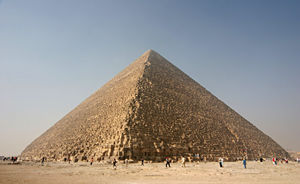
Serapis was the architect of the Great Pyramid and El Morya was the master mason. The Great Pyramid is the carving in stone of the record of the path of initiation whereby the soul, beginning in Matter, the base of the pyramid, the four sides, rises from the center of the pyramid to the apex. The raising up of that flame is the meditation upon the white light that travels in the physical body from the base of the spine to the crown.
Jesus and El Morya explain that “the building of the pyramid of Self is an inner building, but the outer equation must comply, must show fruits, must set the example that others may follow you all the way to the heart of the Sphinx—to the very heart of the living Guru whom the Sphinx represents and to the heart of the flame within the Great Pyramid that is on the etheric octave (and is not held in the pyramid of Giza, which remains the shell of its former focus and function due to the misuse of its energy by black magicians and false gurus and false chelas).”[2]
Amenhotep III
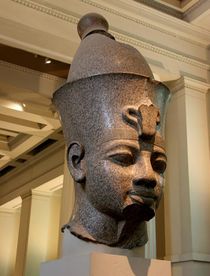
Serapis was embodied as the Egyptian Pharaoh Amenhotep III (reigned c. 1417–1379 B.C.), the son of Thutmose IV and the great grandson of Thutmose III, an incarnation of Kuthumi. His son and successor to the throne was Amenhotep IV, later known as Ikhnaton. During Serapis’ reign, Egypt was at her height of prosperity, peace and splendor, which were the direct manifestation of his communion with his own heart flame and with the ascended masters all the way back to the Ancient of Days.
Amenhotep III was regarded as the greatest ruler on earth. He maintained a high level of peaceful diplomatic relations with all nations during most of his reign. Part of the great wealth of his treasury was spent on the construction of magnificent temples and palaces. He enlarged the existing Temple of Karnak of the Nile, and he built a huge funerary temple, the remains of which are known today as the Colossi, the monolithic seated statues uncovered on the banks of the river. He sought to outpicture in stone the understanding of the hierarchical order of initiates, of ascended masters, of philosopher kings who had walked the earth in the earlier golden ages.
His greatest construction was that of the temple of Luxor, which remains partially intact today. This temple embodied in its geometry and design the physical outpicturing of the esoteric law that had been passed down through the priesthood for generations. It stands as a thorough textbook of advanced science, art and philosophy. The temple of Luxor is the physical counterpart today of the etheric retreat that is the Ascension Temple.
Leonidas
► Main article: Thermopylae
Serapis also embodied as the Spartan king Leonidas (died c. 480 B.C.), who commanded the Greeks in their heroic stand against the immense Persian invasion at the pass of Thermopylae, gateway to central Greece.
Although the Persians overwhelmingly outnumbered the Greeks, Leonidas resisted the advance of the Persian army under King Xerxes for two days. On the third day, when the Persians approached from the rear and no reinforcements were in sight, Leonidas dismissed most of his troops. Assisted by the remaining Greek allies, Leonidas and his three-hundred-member Spartan royal guard fought to the last man. Their heroic stand enabled the Greek fleet to retreat and later defeat the Persians. The example of Leonidas has helped to carry on the spark of national identity of the Greek nation.
Historians cite this battle as a prime example of courage and fearlessness in fighting for a cause against massive odds. The akashic record reveals that the three hundred Spartans were the assembling again of three hundred chelas of Luxor who were in embodiment with Serapis. They were an extraordinary type of manhood. Some are today ascended masters; some remain in embodiment.
At that time, it was a physical war against physical odds. Today, it is a battle of Armageddon against spiritual wickedness in high places of Church and State—the mind of God consuming the anti-mind, the greater Self consuming the not-self.
Phidias
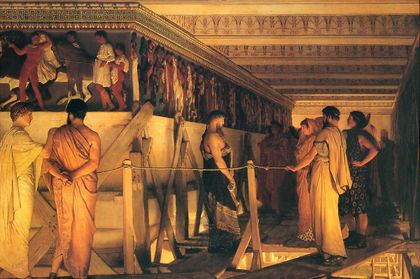
Serapis Bey was embodied as the sculptor Phidias during the fifth century B.C. in Athens. He was regarded as the greatest of all the Greek sculptors. He was the architect of the Parthenon, supervising its exquisitely masterful construction. Within the Parthenon he placed his most famous work, the forty-foot high statue in gold and ivory of Pallas Athena, the representation of the Mother figure, the Goddess of Truth.
Standing in the Parthenon, one stands in the presence of a piece of architecture that is designed by an individual who knows how to use form, symmetry, geometry, angles for the housing of a flame. The forcefield of the Parthenon does contain an essential flame, as do the Temple of Luxor and the Great Pyramid.
Phidias also created a huge statue of Zeus out of gold and ivory that stood in the temple of Olympia. He was also a painter, engraver and master of metalwork. His art is characterized by its exalted beauty and spirituality, and he lived as the ultimate personification of the golden age of Grecian master artists who had an enduring influence on all subsequent Western art.
As far as we know, Serapis Bey ascended about 400 B.C.
Worship in Egypt
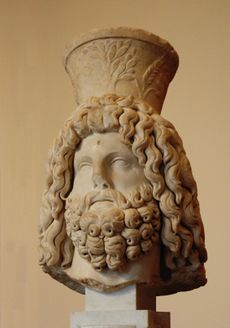
In the Hellenistic age, from 323 to 31 B.C., Serapis became one of the most important gods of the Egyptian and Greco-Roman pantheons. He was revered as the patron of the Ptolemaic kings of Egypt and as the founding deity of the great city of Alexandria. There are numerous historical records of the intimate contact of Serapis with men throughout Egypt and Asia Minor, and there are over 1,080 statues, temples and monuments dedicated to Serapis Bey that were erected during that era.
Demetrius of Phalarum, the founder of the Alexandrian library under Ptolemy I, was miraculously cured of blindness by Serapis and wrote hymns of thanksgiving. Serapis often spoke through oracles and gave counsel as well as personal, miraculous healings to many people. There is a famous historical account involving Serapis that marked an important era in the establishment of him as the most prominent deity of Egypt and Greece. King Ptolemy I, ruler of Egypt, was visited in a dream by Serapis, who commanded the king to bring the god’s statue to Alexandria. After vacillation and a second dream with Serapis, the king had the statue brought with the blessings of the Delphic Oracle and installed it in the Serapium, or great Temple, of Alexandria. This is the temple that contained the famous Alexandrian library of three hundred thousand volumes.
Many epithets are ascribed to Serapis, including “Father,” “Saviour” and “the greatest of the deities.” He was regarded as the sponsor of intimate contact between the gods and mortals. Serapis is regarded in the annals of the esoteric tradition as the hierophant of the secret Egyptian initiatory rites. The lesser mysteries were dedicated to Isis and intended for the layman; the greater mysteries were dedicated to Serapis and Osiris and transmitted only to initiated priests who underwent severe rites of trial and initiation in the temple of Serapis.
Over a period of six to seven hundred years, Serapis became the supreme deity of Egypt and Greece. However, in the late fourth century A.D., the emperor Theodosius issued edicts against polytheism, and Christians took this as license to attack pagans, including the adherents of mystery religions. The Christian Bishop of Alexandria provoked mobs to destroy the great symbol of paganism in Alexandria, the mystery temple of the god Serapis. They hacked apart the huge statue of Serapis, which had inspired worshipers for six hundred years. The mob destroyed at least one of Alexandria’s great libraries.
Work with the Theosophical Society
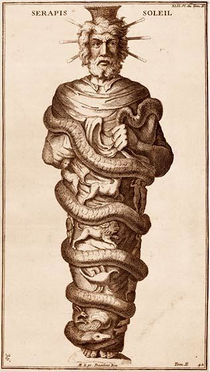
Serapis Bey played a vital role in the initial thrust and direction of the endeavors of the Brotherhood during the nineteenth century. Among the earliest letters from the adepts and masters to the founders of the Theosophical Society were those of Serapis Bey and the Brotherhood of Luxor.
Serapis took personal charge of the direction and chelaship of the amanuensis Helena Blavatsky and of Colonel Henry Steel Olcott, who was the co-founder and the president of the Theosophical Society. During the six months preceding the formation of the society in 1875, Serapis sent many letters of encouragement and instruction to Colonel Olcott. The letters were written mostly on thick green parchment in gold ink, signed by Serapis in script, and inscribed with an esoteric symbol of the Brotherhood of Luxor.
It is characteristic of the letters written to Henry Olcott that he continually gave the exhortation to him, “Try.” The master Serapis stressed the need for courage and fearlessness, the same strong traits he outpictured as Leonidas.
Serapis’ mission today
The ascended master Serapis Bey today occupies a very key position among the seven chohans. The fourth ray is midpoint between three on one side and three on the other. The center figure of four is key because it is the merging of the white light and the nexus of the figure-eight flow of energy. This point of the Mother flame is always embodied in the guru East or West, the person of the Mother in Sanat Kumara who moves in and among us by that white light.
The white light is the sacred fire of creation, and its perversion becomes black magic. This was seen in Egypt, the focal point of the ascension flame, as the practice of black magic by the Egyptian Black Brotherhood that went on for centuries upon centuries in defiance of the very presence of Serapis Bey within his temple.
The point of redemption of earth goes back to Lemuria, the Motherland and the Mother flame itself. Earth has a tremendous karma with the Mother flame and in the perversions of the Mother flame that took place on Lemuria, in the area of where San Francisco is now located and off the coast of California. The perversions of the Mother light opened the way for the desecration of the temples, the fall of the priests and priestesses, ultimately ending in misuse of the sexual energies and perversions of the life force. The final act was the murder of the highest representative of the Mother on Lemuria. The real cause of the sinking of Lemuria was the desecration of the person of the Mother and her flame.
Since that hour, earth has been slowly coming to the age of Aquarius when once again the light of the Mother could be raised up in all, both male and female, bringing about once again the honoring of the woman and of the Mother and a reunion of the Mother, the light rising from the base, with the light of the Father that descends out of the I AM Presence. The next two thousand years is destined to see the raising up of consciousness such as has not occurred since the golden ages of Lemuria.
The path of the ascension is the resolution of those forces that are necessary within our consciousness—Father, Mother, Son and Holy Spirit as the four pillars of the temple within us. Gautama Buddha’s great lesson was that all suffering is caused by being out of alignment with the inner light through wrong desire. Serapis Bey teaches us how to get into alignment with the inner will of Being. His teachings become the keystone in the arch of hierarchy. Without the white light, we cannot enjoy the integration of selfhood.
Serapis Bey, then, becomes a very important key at a time when there are so many problems in society. The increase in crime, murder, rape, drugs, and so forth is the sign of the coming of the Mother light, rising from the altars of Lemuria. The rising light becomes so intense that, unless we dive into it and become a part of it, it becomes the rock that Jesus spoke of—unless we fall upon that rock and allow our misconceptions to be broken, it breaks us.[3]
It is the light that resolves identity, but is also the light that is so powerful that it can destroy the false identity that rebels against it. At the dawning of the age of Aquarius, the world is in rebellion against the light of God, and yet the world is seeking God. The teaching of Serapis Bey and the mysteries of the Brotherhood of Luxor contain the answers that can resolve these questions.
Serapis Bey has legions of seraphim in his command. He has great attainment in divine geometry and design. He assists his disciples in the self-disciplines that are necessary for the ascension: the discipline of the four lower bodies in order that the Christ may appear and use them as vehicles for service and attainment in the world of form; the disciplining of past momentums of negative spirals and of human creation that would stand in the way of the ascension flame forming within the heart of everyone evolving upon the planet through the acceleration of the threefold flame.
The path of the ascension
His book Dossier on the Ascension is a textbook on the path of the ascension. It contains teachings from the classes he conducts at the Ascension Temple, and through it, you can have anchored in your conscious mind that which you learn at the Ascension Temple at Luxor while your body sleeps at night. He outlines the requirements of the ascension and provides a thorough explanation and instruction on the process of the ascension.
Serapis describes what happens during the ritual of the ascension:
It is true, although the form of an individual may show signs of age prior to his ascension, that all of this will change and the physical appearance of the individual will be transformed into the glorified body. The individual ascends, then, not in an earthly body but in a glorified spiritual body into which the physical form is changed on the instant by total immersion in the great God flame.
Thus, man’s consciousness of the physical body ceases and he achieves a state of weightlessness. This resurrection takes place as the great God flame envelops the shell of human creation that remains and transmutes, in a pattern of cosmic grids, all of the cell patterns of the individual—the bony structure, the blood vessels and all bodily processes, which go through a great metamorphosis.
The blood in the veins changes to liquid golden light; the throat chakra glows with an intense blue-white light; the spiritual eye in the center of the forehead becomes an elongated God flame rising upward; the garments of the individual are completely consumed, and he takes on the appearance of being clothed in a white robe—the seamless garment of the Christ. Sometimes the long hair of the Higher Mental Body [the Holy Christ Self] appears as pure gold on the ascending one; then again, eyes of any color may become a beautiful electric blue or a pale violet....
Lighter and lighter grows the physical form, and with the weightlessness of helium the body begins to rise into the atmosphere, the gravitational pull being loosened and the form enveloped by the light of the externalized glory which man knew with the Father “in the beginning” before the world was....
These changes are permanent, and the ascended one is able to take his light body with him wherever he wishes, or he may travel without the glorified spiritual body. Ascended beings can and occasionally do appear upon earth as ordinary mortals, putting on physical garments resembling the people of earth and moving among them for cosmic purposes. This Saint Germain did after his ascension when he was known as the Wonderman of Europe. Such an activity is a matter of dispensation received from the Karmic Board.[4]
(Generally, however, ascended beings do not return to the physical plane unless there is some specific service requiring this change in vibratory rate.)
Serapis tells us, “You ascend daily.” Our thoughts, our feelings, our daily deeds are all weighed in the balance. We do not ascend all at once, but by increments as we pass our tests and win our individual victories. The entire record of all our past lives and momentums of both good and evil must be counted; and then, when we have brought at least 51 percent of all the energy that has ever been allotted to us into balance with the purity and harmony of the Great God Self, we may be offered the gift of the ascension. The remaining 49 percent must be transmuted, or purified, from the ascended octaves through service to earth and her evolutions.[5]
Serapis Bey, the chohan of the ascension flame and hierarch of the Ascension Temple at Luxor, Egypt, speaks to each one of us:
The future is what you make it, even as the present is what you made it. If you do not like it, God has provided a way for you to change it, and the way is through the acceptance of the currents of the ascension flame.[6]
Guiseppe Verdi captured the music of the ascension flame in the “Triumphal March” from Aïda. The keynote of the Ascension Temple is “Liebestraum,” by Franz Liszt, and the radiance of the Electronic Presence of Serapis Bey and his twin flame pour through the aria “Celeste Aïda.”
See also
For more information
Mark L. Prophet and Elizabeth Clare Prophet, Lords of the Seven Rays.
Serapis Bey, Dossier on the Ascension.
Sources
Mark L. Prophet and Elizabeth Clare Prophet, The Masters and Their Retreats, s.v. “Serapis Bey.”
- ↑ Serapis Bey, “The Mobilization of Spiritual Forces,” Pearls of Wisdom, vol. 25, no. 60.
- ↑ Jesus and El Morya, “The Order of the Good Samaritan,” Pearls of Wisdom, vol. 27, no. 52, October 28, 1984.
- ↑ Matt. 21:44; Luke 20:18.
- ↑ Serapis Bey, Dossier on the Ascension, pp. 158, 176–77.
- ↑ In addition to balancing 51 percent of one’s karma, the requirements for the ascension are to balance the threefold flame, align the four lower bodies, attain a certain mastery on all seven rays, achieve a degree of mastery over outer conditions, fulfill one’s divine plan, transmute the electronic belt, and raise the Kundalini.
- ↑ Ibid., p. 89.
